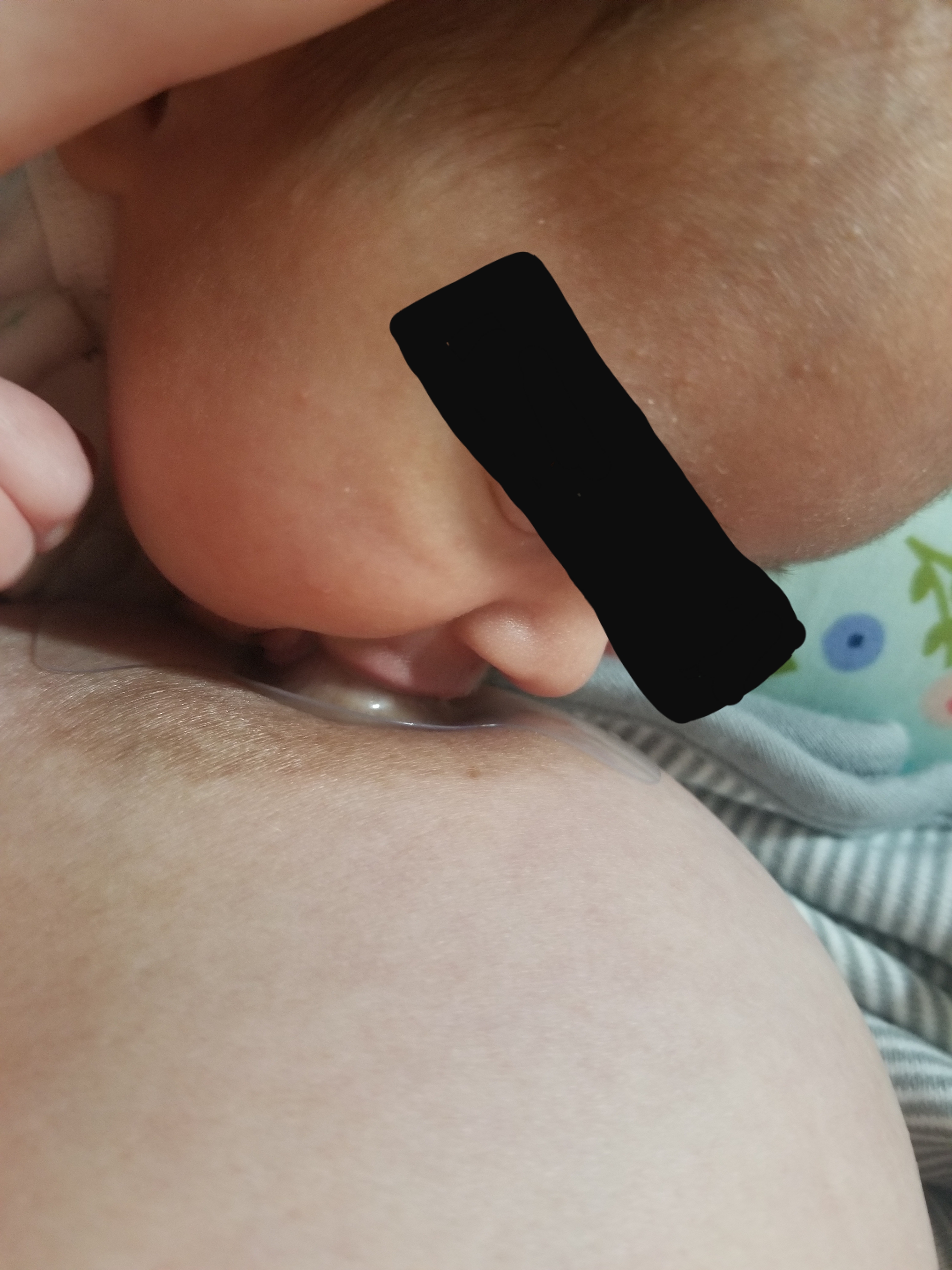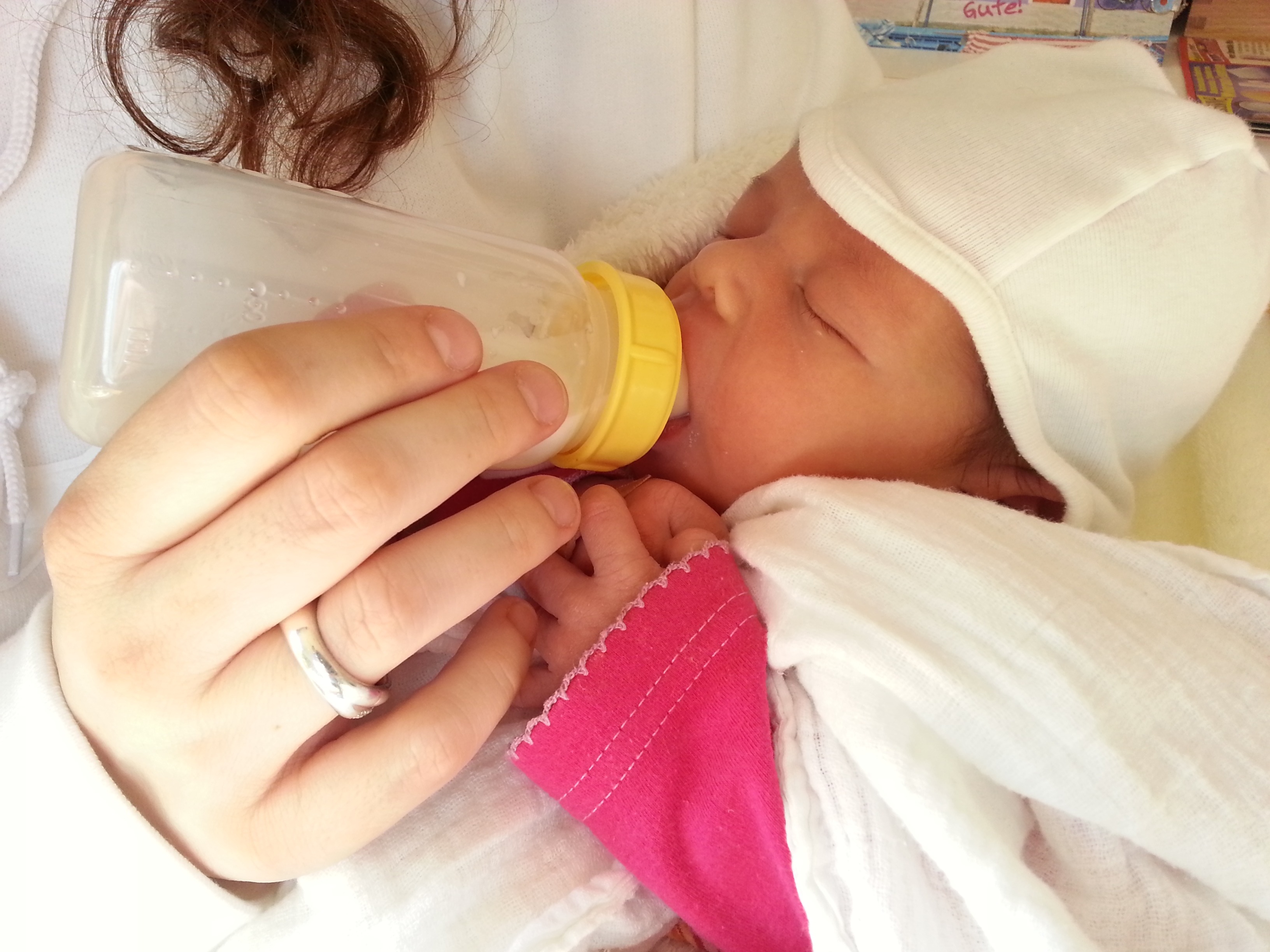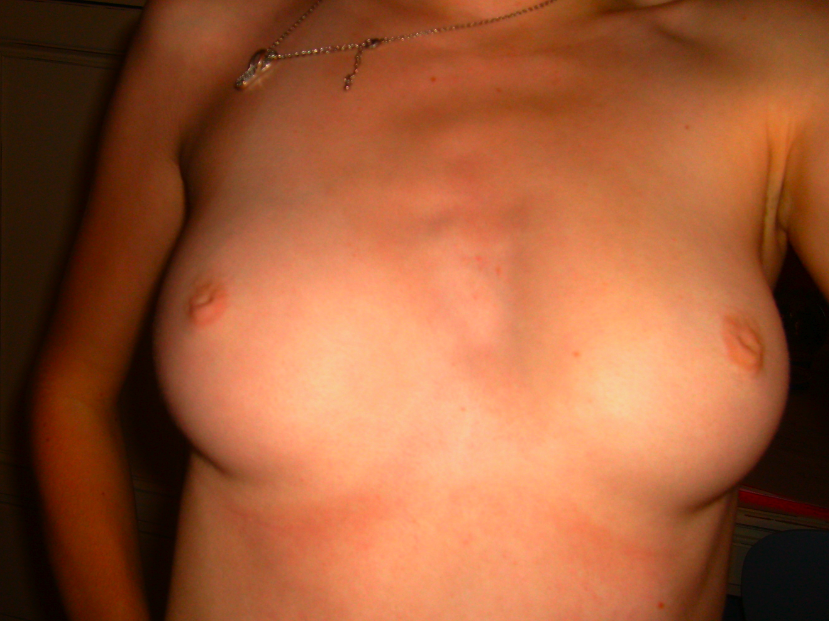|
Nipple Shield (breastfeeding)
A nipple shield is a nipple-shaped sheath worn over the areola and nipple during breastfeeding. Modern nipple shields are made of soft, thin, flexible silicone and have holes at the end of the nipple section to allow the breast milk to pass through. Usage File:Siliconen tepelhoedje - vorm na aanbrengen.JPG, Silicone nipple shield File:Siliconen tepelhoedje - vorm voor aanbrengen.jpg, Shape inverted before application File:Placing_shield.jpg, Placing shield File:Placed_shield2.jpg, Shield applied File:Nipple_shield4.jpg, Infant starts to latch File:Nipple_shield3.jpg, Infant fully latched on Nipple shields are used in various situations: * Some mothers have small or inverted nipples which make it difficult for the baby to latch on. Using a shield allows for feeding to progress until the baby's suction draws out the nipple. * Small, weak or sick babies often have difficulty latching on to the breast. A nipple shield makes latching easier and prevents the baby becoming discoura ... [...More Info...] [...Related Items...] OR: [Wikipedia] [Google] [Baidu] |
Nipple Shield3
The nipple is a raised region of tissue on the surface of the breast from which, in females, milk leaves the breast through the lactiferous ducts to feed an infant. The milk can flow through the nipple passively or it can be ejected by smooth muscle contractions that occur along with the ductal system. The nipple is surrounded by the areola, which is often a darker colour than the surrounding skin. A nipple is often called a teat when referring to non-humans. Nipple or teat can also be used to describe the flexible mouthpiece of a baby bottle. In humans, the nipples of both males and females can be stimulated as part of sexual arousal. In many cultures, human female nipples are sexualized, or "regarded as sex objects and evaluated in terms of their physical characteristics and sexiness." Anatomy In mammals, a nipple (also called mammary papilla or teat) is a small projection of skin containing the outlets for 15–20 lactiferous ducts arranged cylindrically around the tip. Mar ... [...More Info...] [...Related Items...] OR: [Wikipedia] [Google] [Baidu] |
Lactation Consultant
A lactation consultant is a health professional who specializes in the clinical management of breastfeeding. The International Board of Lactation Consultant Examiners (IBLCE) certifies lactation consultants who meet its criteria and have passed its exam. Description Lactation consultants are trained to assist mothers in preventing and solving breastfeeding difficulties such as sore nipples and low milk supply. They commonly work in hospitals, physician or midwife practices, public health programs, and private practice. In the United States, lactation consultants are often nurses, midwives, nurse practitioners, and dieticians who have obtained additional certification. History and organization The IBLCE was founded by a group of La Leche League leaders who wanted to professionalize the skills they had developed while working with breastfeeding mothers. Candidates can choose various pathways to qualify, including options for current health professionals and volunteers, through c ... [...More Info...] [...Related Items...] OR: [Wikipedia] [Google] [Baidu] |
Breast Petal
Pasties (singular pasty or pastie) are patches that cover a person's nipples and areolae, typically self-adhesive or affixed with adhesive. They originated as part of burlesque shows, providing a commercial form of bare-breasted entertainment. They are also worn as an undergarment in lieu of a bra, or visibly as a fashion accessory, and are sometimes called nipple stickers. Pasties are also, at times, used while sunbathing, worn by strippers and exotic dancers, or as a form of protest during women's rights events such as Go Topless Day. In some cases this is to avoid potential prosecution under indecency laws. Pasties are sometimes worn by bikini baristas, staff hired to serve coffee from roadside huts while wearing lingerie, thongs, or skimpy swimwear. Design Pasties come in a variety of colors, shapes, and sizes. They are often smaller in countries such as Japan than they are in America as they are typically not much larger than the areola. No straps are used to hold past ... [...More Info...] [...Related Items...] OR: [Wikipedia] [Google] [Baidu] |
Pasties
Pasties (singular pasty or pastie) are patches that cover a person's nipples and areolae, typically self-adhesive or affixed with adhesive. They originated as part of burlesque shows, providing a commercial form of bare-breasted entertainment. They are also worn as an undergarment in lieu of a bra, or visibly as a fashion accessory, and are sometimes called nipple stickers. Pasties are also, at times, used while sunbathing, worn by strippers and exotic dancers, or as a form of protest during women's rights events such as Go Topless Day. In some cases this is to avoid potential prosecution under indecency laws. Pasties are sometimes worn by bikini baristas, staff hired to serve coffee from roadside huts while wearing lingerie, thongs, or skimpy swimwear. Design Pasties come in a variety of colors, shapes, and sizes. They are often smaller in countries such as Japan than they are in America as they are typically not much larger than the areola. No straps are used to hold past ... [...More Info...] [...Related Items...] OR: [Wikipedia] [Google] [Baidu] |
Pewter
Pewter () is a malleable metal alloy consisting of tin (85–99%), antimony (approximately 5–10%), copper (2%), bismuth, and sometimes silver. Copper and antimony (and in antiquity lead) act as hardeners, but lead may be used in lower grades of pewter, imparting a bluish tint. Pewter has a low melting point, around , depending on the exact mixture of metals. The word ''pewter'' is probably a variation of the word ''spelter'', a term for zinc alloys (originally a colloquial name for zinc). History Pewter was first used around the beginning of the Bronze Age in the Near East. The earliest known piece of pewter was found in an Egyptian tomb, c. 1450 BC, but it is unlikely that this was the first use of the material. Pewter was used for decorative metal items and tableware in ancient times by the Egyptians and later the Romans, and came into extensive use in Europe from the Middle Ages until the various developments in pottery and glass-making during the 18th and 19th centuries. ... [...More Info...] [...Related Items...] OR: [Wikipedia] [Google] [Baidu] |
Latex
Latex is an emulsion (stable dispersion) of polymer microparticles in water. Latexes are found in nature, but synthetic latexes are common as well. In nature, latex is found as a milky fluid found in 10% of all flowering plants (angiosperms). It is a complex emulsion that coagulates on exposure to air, consisting of proteins, alkaloids, starches, sugars, oils, tannins, resins, and gums. It is usually exuded after tissue injury. In most plants, latex is white, but some have yellow, orange, or scarlet latex. Since the 17th century, latex has been used as a term for the fluid substance in plants, deriving from the Latin word for "liquid". It serves mainly as defense against herbivorous insects. Latex is not to be confused with plant sap; it is a distinct substance, separately produced, and with different functions. The word latex is also used to refer to natural latex rubber, particularly non-vulcanized rubber. Such is the case in products like latex gloves, latex condoms ... [...More Info...] [...Related Items...] OR: [Wikipedia] [Google] [Baidu] |
Sterling Silver, Ivory And Glass Nipple-shield Wellcome L0035701
Sterling may refer to: Common meanings * Sterling silver, a grade of silver * Sterling (currency), the currency of the United Kingdom ** Pound sterling, the primary unit of that currency Places United Kingdom * Stirling, a Scottish city whose alternative historical spelling is Sterling United States * Sterling, Alaska * Sterling, Colorado * Sterling Micropolitan Statistical Area, Colorado * Sterling, Connecticut * Sterling, Georgia * Sterling, in Bingham County, Idaho * Sterling Wildlife Management Area, Idaho * Sterling, Illinois * Sterling, a ghost town in Jackson County, Iowa * Sterling, Kansas * Sterling, Massachusetts * Sterling, Michigan * Sterling Heights, Michigan * Sterling State Park, Michigan * Sterling Center, Minnesota * Sterling, Missouri * Sterling, in Madison County, Montana * Sterling, Nebraska * Sterling, New York * Sterling, in Mecklenburg County, North Carolina * Mount Sterling (Great Smoky Mountains), North Carolina * Sterling, North Dakota * Sterling, ... [...More Info...] [...Related Items...] OR: [Wikipedia] [Google] [Baidu] |
Breast Shell
Breast shells are hollow, lightweight plastic disks worn inside the brassiere to help correct flat or inverted nipples either in preparation for or during breastfeeding. Also known as milk cups, breast cups, breast shields, or Woolwich shields, they can also be used to ease sensitive nipples or collect milk when the baby has not finished the teat. Breast shells function by applying gentle but firm pressure to the region surrounding the nipple to stretch underlying adhesions and draw out the nipple. Nipple shields may be confused with breast shells, but shields are intended for use during the act of breastfeeding, whereas breast shells are worn in preparation for or after breastfeeding. Usage A breast shell is composed of inner and outer sections which snap together and enclose the nipple. The inner section, which encircles the nipple and puts pressure on the surrounding breast tissue, is often lined with soft material such as silicone. The rigid outer section separates the nipple ... [...More Info...] [...Related Items...] OR: [Wikipedia] [Google] [Baidu] |
Cracked Nipple
Cracked nipple (nipple trauma or nipple fissure) is a condition that can occur in breastfeeding women as a result of a number of possible causes. Developing a cracked nipple can result in soreness, dryness or irritation to, or bleeding of, one or both nipples during breastfeeding. The mother with a cracked nipple can have severe nipple pain when the baby is nursing. This severe pain is a disincentive for continued breastfeeding. The crack can appear as a cut across the tip of the nipple and may extend to its base. Cracked nipple develop after the birth of the infant and is managed with pharmacological and nonpharmacological treatment. Signs and symptoms Cracked nipples are classified as a breast disorder. The nipple is not only the structure to deliver milk to the infant, it also contains small, sebaceous glands or Montgomery glands to lubricate the skin of the areola. Cracked nipples are most often associated with breastfeeding and appear as cracks or small lacerations or breaks ... [...More Info...] [...Related Items...] OR: [Wikipedia] [Google] [Baidu] |
Areola
The human areola (''areola mammae'', or ) is the pigmented area on the breast around the nipple. Areola, more generally, is a small circular area on the body with a different histology from the surrounding tissue, or other small circular areas such as an inflamed region of skin. The mature human female nipple has several small openings arranged radially around the tip of the lactiferous ducts from which milk is released during lactation. Other small openings in the areola are sebaceous glands, also known as areolar glands. Shade The areolae can range from pink to red to brown to dark brown or nearly black, but generally tend to be paler among people with lighter skin tones and darker among people with darker skin tones. A reason for the differing color may be to make the nipple area more visible to the infant. Size and shape The size and shape of areolae and nipples are also highly variable, with those of women usually being larger than those of men and prepubescent girl ... [...More Info...] [...Related Items...] OR: [Wikipedia] [Google] [Baidu] |
Baby Bottle
A baby bottle, nursing bottle, or feeding bottle is a bottle with an attached ''teat'' (also called a ''nipple'' in the US) on the top opening, on which can be suckled, and from thereby drunk directly. It is typically used by infants and young children, or if someone cannot (without difficulty) drink from a cup, for feeding oneself or being fed. It can also be used to feed non-human mammals. Hard plastic is the most common material used, being transparent, light-weight, and resistant to breakage. Glass bottles have been recommended as being easier to clean, less likely to retain formula residues, and relatively chemically inert. Hybrid bottles using plastic on the outside and glass inside have also been developed. Other materials used for baby bottles include food-grade stainless steel and silicone rubber. Baby bottles can be used to feed expressed breast milk, infant formula, or pediatric electrolyte solution. A 2020 review reports that healthy term infants, when bre ... [...More Info...] [...Related Items...] OR: [Wikipedia] [Google] [Baidu] |
Inverted Nipple
An inverted nipple (occasionally invaginated nipple) is a condition where the nipple, instead of pointing outward, is retracted into the breast. In some cases, the nipple will be temporarily protruded if stimulated. Both women and men can have inverted nipples. Causes The most common causes of nipple inversion include: * Born with condition * Trauma which can be caused by conditions such as fat necrosis, scars, or a result of surgery * Breast sagging, drooping or ptosis * Breast cancer **Breast carcinoma ** Paget's disease **Inflammatory breast cancer * Breast infections or inflammations **Mammary duct ectasia **Breast abscess **Mastitis * Genetic variant of nipple shape, such as: **Weaver syndrome **Congenital disorder of glycosylation type 1A and 1 L ** Kennerknecht-Sorgo-Oberhoffer syndrome * Gynecomastia * Recurrent infections * Tuberculosis Most common nipple variations that women are born with are caused by short ducts or a wide areola muscle sphincter. Inverted nipples ... [...More Info...] [...Related Items...] OR: [Wikipedia] [Google] [Baidu] |


.jpg)






